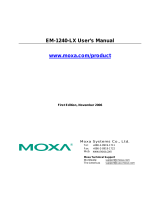
UC-7112-LX Plus/UC-7112/UC-7110 Hardware Introduction
Overview
The UC-7110/7112 series of RISC-based communication platforms are ideal for embedded applications. All
three computers in the series (UC-7110, UC-7112, and UC-7112 Plus) come with 2 RS-232/422/485 serial
ports and dual 10/100 Mbps Ethernet LAN ports to provide users with a versatile communication platform.
The UC-7110/7112 series computers use the Moxa ART ARM9 192 MHz RISC CPU. Unlike the x86 CPU, which
uses a CISC design, the ARM9’s RISC design architecture and modern semiconductor technology provide these
computers with a powerful computing engine and communication functions, but without generating too much
heat. The built-in NOR Flash ROM (8 MB for UC-7110/7112, 16 MB for UC-7112 Plus) and SDRAM (16 MB for
UC-7110/7112, 32 MB for UC-7112 Plus) give you plenty of storage capacity, and the SD socket provides
greater flexibility for running various applications. The dual LAN ports built into the ARM9 allow the UC-71xx
computers to be used as communication platforms for basic data acquisition and protocol conversion
applications, and the two RS-232/422/485 serial ports allow you to connect a variety of serial devices.
The UC-7110 and UC-7112 come with the µClinux operating system pre-installed, and the UC-7112 Plus comes
with the Linux operating system with MMU support pre-installed. Software written for desktop PCs is easily
ported to the UC-71xx computers with a GNU cross complier, so that you will not need to spend time modifying
existing software code. The operating system, device drivers, and your own software can all be stored in the
computers’ Flash memory.
Package Checklist
The UC-7110/7112 series currently includes four models:
Standard Operating Temperature Models (-10 to 60°C)
UC-7110-LX
Ready-to-run embedded RISC computing platform with 2 Serial Ports, dual eEthernet, μClinux OS.
UC-7112-LX
Ready-to-run embedded RISC computing platform with 2 Serial Ports, dual eEthernet, SD slot, μClinux OS.
UC-7112-LX Plus
Ready-to-run embedded RISC computing platform with 2 Serial Ports, dual eEthernet, SD slot, Linux OS.
Wide Operating Temperature Model (-40 to 75°C)
UC-7110-T-LX
Ready-to-run embedded RISC computing platform with 2 Serial Ports, dual eEthernet, μClinux OS, Wide
Temperature.
Each model is shipped with the following items:
• 1 UC-7110 or UC-7112 or UC-7112 Plus
• Quick installation guide (printed)
• Document & software CD
• Ethernet Cable: RJ45 to RJ45 cross-over cable, 100 cm
• CBL-4PINDB9F-100: 4-pin header to DB9 female console port cable, 100 cm
• Universal Power Adaptor
• Warranty card
Optional Accessories
• 35 mm DIN-Rail Mounting Kit (DK-35A)
NOTE: Please notify your sales representative if any of the above items are missing or damaged.




















